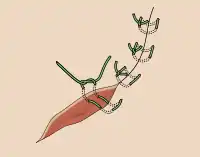Horizontal mattress stitch


The horizontal mattress stitch is a suture technique used to close wounds. It everts skin well and spreads tension along the wound edge.[1][2][3] This makes it ideal for holding together fragile skin[4] as well as skin under high tension such as the distant edges of a large laceration or as the initial holding suture in complicated repairs.[1][3][5]
The horizontal mattress is so secure that it can compromise blood supply to the tissue contained within the stitch. This can be helpful to prevent wound bleeding, but it can cause strangulation and skin necrosis if tied too tightly.[1] Sometimes cushioning materials can be placed within the stitch to mitigate this effect.[1][3][5][6] Like other mattress stitches, the horizontal mattress can sometimes leave small skin scars called "railroad marks;" for this reason it is rarely used on the face, and is removed promptly even when placed elsewhere.[4] The knot is parallel adjacent to the wound edge.
References
- 1 2 3 4 Zuber, TJ (1998). "Skin biopsy, excision, and repair techniques". Soft tissue surgery for the family physician. Kansas City, Missouri: American Academy of Family Physicians. pp. 100–6.
- ↑ Coldiron, BM (1989). "Closure of wounds under tension. The horizontal mattress suture". Archives of Dermatology. 125 (9): 1189–90. doi:10.1001/archderm.125.9.1189. PMID 2673047.
- 1 2 3 Chernosky, ME (1987). "Scalpel and scissors surgery as seen by the dermatologist". In Epstein E, Epstein E Jr (ed.). Skin surgery (6th ed.). Philadelphia: Saunders. pp. 88–127.
- 1 2 Zuber, Thomas (December 15, 2002). "The Mattress Sutures: Vertical, Horizontal, and Corner Stitch". American Family Physician. 66 (12): 2231–6. PMID 12507160.
- 1 2 Stegman, SJ; Tromovitch, TA; Glogau, RG (1982). Basics of dermatologic surgery. Chicago: Year Book Medical. pp. 42–5. ISBN 0-8151-8168-X.
- ↑ Swanson, NA (1987). Atlas of cutaneous surgery. Boston: Little, Brown. pp. 30–5. ISBN 0-316-82474-7.